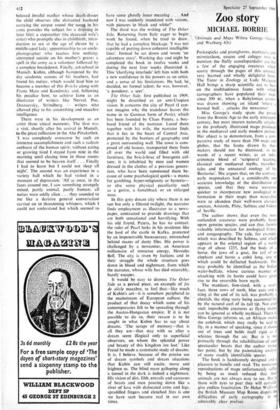Zoo story
MICHAEL BOBBIE
oAnitnals and Maps Wilma George (Seeker and Warburg 63s) Porkespicks and pronghorns, manticora and mirmicaleon, cuscus and colugos (not to mention the fluffy camelopardalis) are but a few of . the engaging creatures which scurry through the pages of this unusual. very learned and wholly delightful book. The Tutor in Zoology at Lady Margaret Hall brings a sharp scientific eye to bear on the multitudinous fauna with which cartographers have populated their map, since 500 BC, when a Babylonian cosmos was drawn showing an island 'where a horned bull. . .attacks the newcomer'.
Miss George's study spans the period from the Bronze Age to the early nineteenth century, but most interest naturally attaches to the profusely illustrated maps produced in the mediaeval and early modern periods. Her object is to demonstrate, from a com- parative study of more than 350 maps and globes, that the fauna drawn by their makers should not be dismissed, in the words of a recent writer, as an indis- criminate blend of 'scriptural teaching. classical and mediaeval myths, travellers' tales and the unnatural zoology of the Bestiaries'. She argues that, on the contrary. early mapmakers had a considerable and accurate knowledge of the distribution of species, and that they were moreover quicker to incorporate' new zoological in- formation in their maps than naturalists were to abandon their well-worn classical sources, Aristotle, Pliny, Solinus and Isidore of Seville.
The author shows that even the most outlandish creatures were probably based upon genuine species, and can thus furnish valuable information for zoological history and zoogeography. The yale, for example. which was described by Solinus, and which appears in the oriental region of a world map of about 1235, had the body of a horse, the jaws of a goat, the tail of an elephant and horns a cubit long, one of which could be deflected backwards. This may probably be identified as the Indian water-buffalo, whose curious manner of attacking with its horns could have gisen rise to the reversible horn myth.
The manticor, lion-sized, with a man., face, three rows of teeth, blue eyes and a sting at the end of its tail, was probably a cheetah, the sting story being accounted for by the natural curl of its tail tip. Not even such improbable creatures as flying snakes can be ignored as wholly mythical. There is. Miss George informs us, an African snake. the colubrid, which may really be said to fly, in a manner of speaking, since it shoots out of trees and holds itself rigid as it whizzes through the air. But it is not ' primarily through the rehabilitation of such spectacular beasts that the • author makes her point, but by the painstaking analy4 of many readily identifiable species.
The book is handsomely designed and a pleasure to handle and read. The numerous reproductions of maps unfortunately suffer by being so much reduced that their animals are not always easy to see. But to those with eyes to peer they will certain]) give endless fascination. Dr Helen Wallis of the British Museum Map Room dispels th difficulties of early cartography in an admirably clear preface.






































 Previous page
Previous page